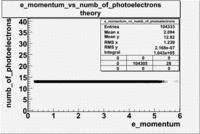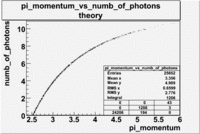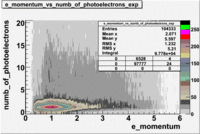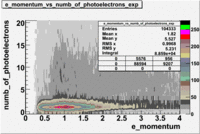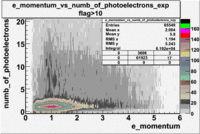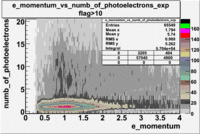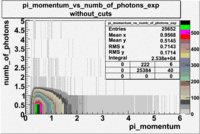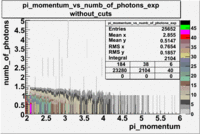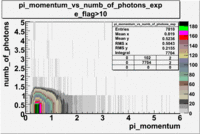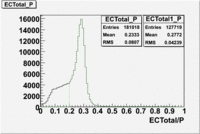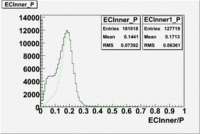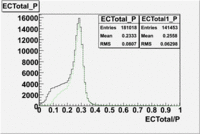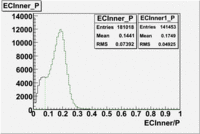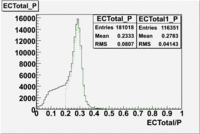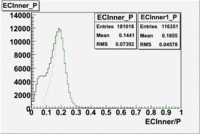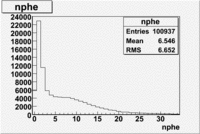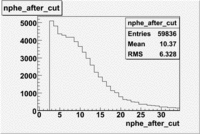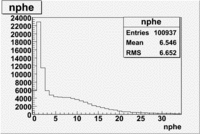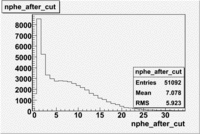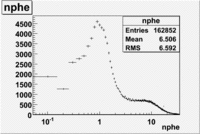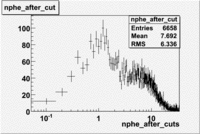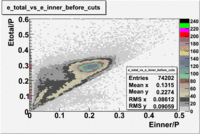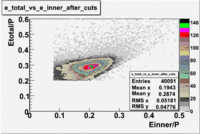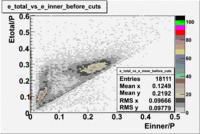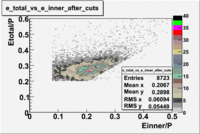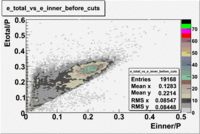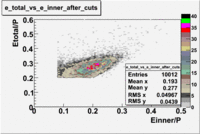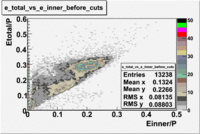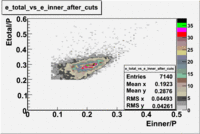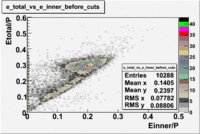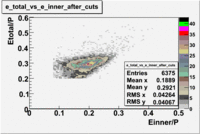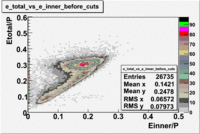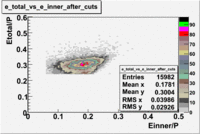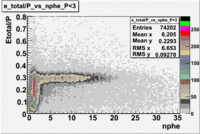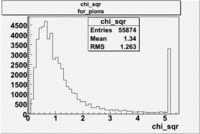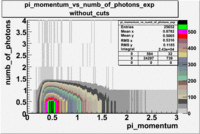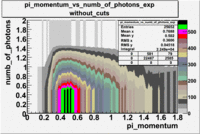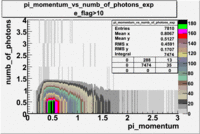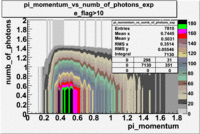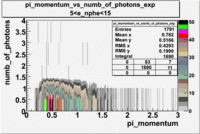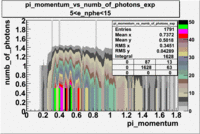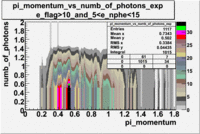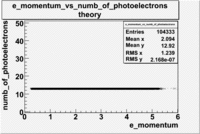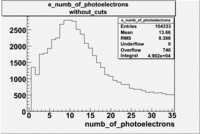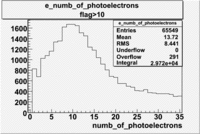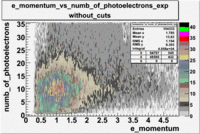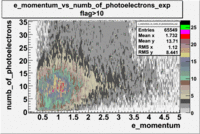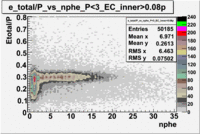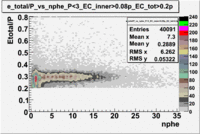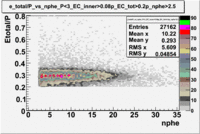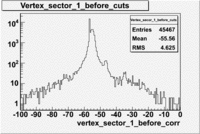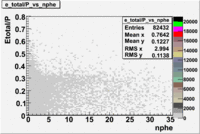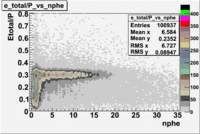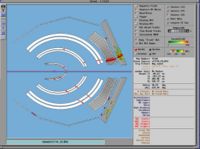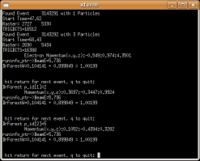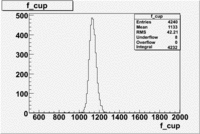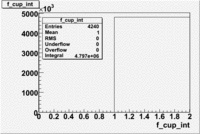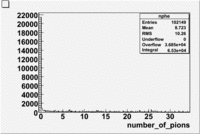Difference between revisions of "Analysis"
| Line 598: | Line 598: | ||
<math>\vec {P_{tot}}^{\prime} = (p_{ex}^{\prime} + p_{px}^{\prime} + p_{\pi^-x}^{\prime})\hat{x} + (p_{ey}^{\prime} + p_{py}^{\prime} + p_{\pi^-y}^{\prime})\hat{y} + (p_{ez}^{\prime} + p_{pz}^{\prime} + p_{\pi^-z}^{\prime})\hat{z} = - 0.0741 \hat{x} + 0.1899 \hat{y} + 0.13 \hat{z} </math><br> | <math>\vec {P_{tot}}^{\prime} = (p_{ex}^{\prime} + p_{px}^{\prime} + p_{\pi^-x}^{\prime})\hat{x} + (p_{ey}^{\prime} + p_{py}^{\prime} + p_{\pi^-y}^{\prime})\hat{y} + (p_{ez}^{\prime} + p_{pz}^{\prime} + p_{\pi^-z}^{\prime})\hat{z} = - 0.0741 \hat{x} + 0.1899 \hat{y} + 0.13 \hat{z} </math><br> | ||
| + | |||
| + | [[Image:missing_mass_calculation.ods]] | ||
Revision as of 22:02, 25 November 2007
EG1 run database
run summary
polarization info
Particle Identification
Cherenkov
Cherenkov Theory
The number of photons produced per unit path length of a particle with charge ze and per unit energy interval of the photons is[1]
where is the angle of Cerenkov radiation relative to the particle's direction, - the particle's velocity and n - index of refraction of the medium.
after deriving the Taylor expansion of our function and considering only the first two terms, we get
The gas used in the CLAS Cerenkov counter is perfluorobutane with index of refraction equal to 1.00153.
Electrons
Insert number of Photo-electrons calculation and sentence saying that themean should be about 10PEs.
Used file dst27095_05.B00 energy=5.7GeV and torus=2250(B>0). Target NH3
Pions()
The threshold energy for pions is ~2.5 GeV and for electrons 9 MeV.
- Example for
, momentum and n=1.00153
where
The Hall B cherenkov detector is m thick radiator. We assume the PMTs used to collect light have a constant quantum efficiency of 8% for photons with wavelength between 300 and 600 nm.
=
- For the number of photons we have the following(for pions)
Used file dst27095_05.B00 energy=5.7GeV and torus=2250(B>0). Target NH3
CLAS Cherenkov signal
Electrons
The cherenkov signal measured in CLAS for particles identified as electrons by the tracking algorithm is shown below. There are two distributions present. One distribution is centered around 1.5 PEs and the second distribution is at 7 PEs when two gaussians are fit to the spectrum. As we will show below, the first peak is due to the misidentification of a negative pion as an electron.
- Number of photoelectrons
| Theory | |||
|---|---|---|---|
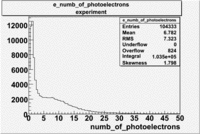
|
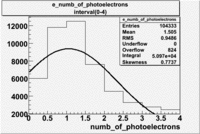
|
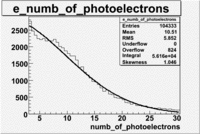
| |
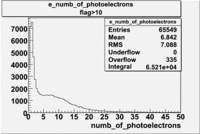
|
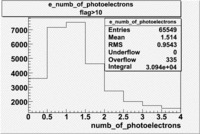
|
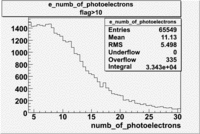
|
- e_Momentum_vs_Number_of_Photoelectrons
| Experiment | B>0 | without cuts | flag>10 | 5<nphe<15 | 5<nphe<15 and flag>10 |
|---|---|---|---|---|---|
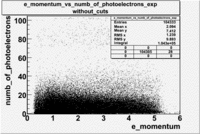
|
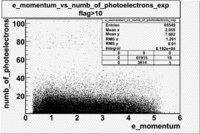
|
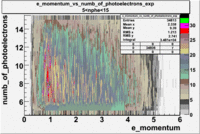
|
200px |
Pions()
- _Momentum_vs_Number_of_Photons
| Experiment | B>0 | without cuts | e_flag>10 | 0<e_nphe<5 | 0<nphe<5 and e_flag>10 |
|---|---|---|---|---|---|
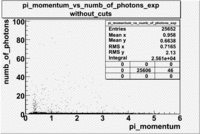
|
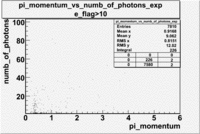
|
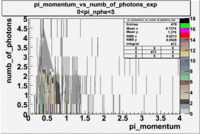
|
200px |
Calorimeter
Electron-pion contamination
Osipenko's CLAS Note 2004-20 File:CLAS Note-2004-020.pdf
Electron
Cuts
Calorimeter based cuts
The distributions below represent two types of cuts applied to improve the electron particle identification (PID) using a 4 GeV electron beam incident on an NH3 target. The electron calorimeter is segmented into an inner and an outer region. The total energy absorbed by the calorimeter system is recorded in the variable . The momentum () is calculated using the reconstructed track and the known torus magnetic field. The distributions of and are shown below where both have been divided by the electron momentum and no cuts have been applied.
Without any cuts we have 181018 entries. After using the following cut we are getting 127719 entries, which is about 70.55% of 181018.
After the cut on the energy deposited into inner part of electron calorimeter, number of entries decreases by 22%.
Both cuts and
In case of using the cuts of the total deposited energy and the energy deposited into inner calorimeter number of entries decreases ~36%
summary table
The "# of triggers" columns represents the number of events which generated a signal above threshold in the calorimeter and the scintillator. The expected # of events column represents the number of reconstructed events with tracks that also make it through the cuts defined in the table.
The semi-inclusive analysis will focus on the 4 GeV and 6 GeV data which have both inbending and outbending torus settings. Specifically runs 28074 - 28579 ( 4 GeV) and Runs 27356 - 27499 and 26874 - 27198 (6 GeV)
| Beam Energy | Torus Current | Begin Run | End Run | file used | cuts | # trig() | expected # evts() | p<3,,(%) | p>3,,(%) | ||
|---|---|---|---|---|---|---|---|---|---|---|---|
| and | |||||||||||
| 1606 | 1500 | 25488 | 25559 | dst25504_02.B00 | 64% | 49.5% | 78% | 60 | 3.2 | ||
| 1606 | 1946 | 25560 | 25605 | 44 | |||||||
| 1606 | 1500 | 25669 | 25732 | dst25669_02.B00 | 64% | 49% | 78% | 226 | 10 | ||
| 1606 | 1500 | 25742 | 26221 | dst25754_02.B00 | 21% | 11% | 24% | 3154 | 13.3 | ||
| 1606 | -1500 | 26222 | 26359 | dst26224_02.B00 | 4.6% | 3% | 6.6% | 703 | 13.1 | ||
| 1724 | -1500 | 27644 | 27798 | dst27649_02.B00 | 4.8% | 2.2% | 5.9% | 211 | 20 | ||
| 1724 | 1500 | 28512 | 28526 | 159 | |||||||
| 1724 | -1500 | 28527 | 28532 | 93 | |||||||
| 2288 | 1500 | 27205 | 27351 | dst27225_02.B00 | 20.2% | 13% | 25.6% | 1647 | 16.1 | ||
| 2562 | -1500 | 27799 | 27924 | dst27809_02.B00 | 5.7% | 4.6% | 8.6% | 1441 | 13.1 | ||
| 2562 | -1500 | 27942 | 27995 | dst27942_02.B00 | 6.1% | 4.4% | 8.9% | 841 | 32.3 | ||
| 2562 | 1500 | 28001 | 28069 | dst28002_02.B00 | 27.8% | 13% | 29.6% | 1013 | 30.7 | ||
| 2792 | -1500 | 27936 | 27941 | dst27937_02.B00 | 6.7% | 5% | 9.9% | 69 | 20.6 | ||
| 3210 | -2250 | 28549 | 28570 | 436 | |||||||
| 4239 | 2250 | 28074 | 28277 | dst28075_02.B00 | 35.3% | 23.9% | 40.5% | 2278 | 19.6 | ||
| 4239 | -2250 | 28280 | 28479 | dst28281_02.B00 | 9.1% | 9.4% | 13.6% | 2620 | 15.2 | ||
| 4239 | 2250 | 28482 | 28494 | 7 | |||||||
| 4239 | -2250 | 28500 | 28505 | 107 | |||||||
| 4239 | 2250 | 28506 | 28510 | dst28509_02.B00 | 29.5% | 22% | 36% | 75 | 18.1 | ||
| 5627 | 2250 | 27356 | 27364 | dst27358_02.B00 | 33.2% | 27.8% | 41.3% | 56 | 19.4 | 44.6 | 40.1 |
| 5627 | -2250 | 27366 | 27380 | dst27368_02.B00 | 12.6% | 14.8% | 19.5% | 130 | 13.6 | 25.3 | 8.8 |
| 5627 | 2250 | 27386 | 27499 | dst27388_02.B00 | 33.4% | 27.8% | 41.4% | 1210 | 20.2 | 44.8 | 40.1 |
| 5627 | 965 | 27502 | 27617 | 493 | |||||||
| 5735 | -2250 | 26874 | 27068 | dst26904_02.B00 | 13% | 15% | 20% | 1709 | 19.9 | 25.6 | 9.1 |
| 5735 | 2250 | 27069 | 27198 | dst27070_02.B00 | 33.3% | 28.8% | 42.2% | 1509 | 15 | 46 | 40.2 |
| 5764 | -2250 | 26468 | 26722 | dst26489_02.B00 | 12.2% | 14.4% | 19.1% | 1189 | 10 | 24.6 | 9.3 |
| 5764 | 0 | 26723 | 26775 | 268 | |||||||
| 5764 | -2250 | 26776 | 26851 | dst26779_02.B00 | 13.5% | 15.5% | 20.5% | 662 | 15.9 | 26.4 | 9.2 |
Cut on the number of photoelectrons
In this case is used a cut on the number of photoelectrons, which is . The plots below show the
effect of the number of photoelectrons cuts on the Cerenkov distribution. We see that after using cut the number of entries decreases ~40.7%
Used cuts and
Used file dst28181_03(energy 4.2GeV). In this case was applied cuts on the polar angle() and momentum(). Number of entries decreased by 96%(?????????????/)
Tamuna: follow this link to see the OSIPENKO cuts described in part 5 add graphs of their effect below
Plot of vs
In this case is used file dst27070(Energy 5.735 GeV and Torus 2250) and are applied the following EC cuts: For ECtotal - , for EC inner - .
P<3
After using above cuts the number of entries decreases ~46%
0.5<P<1
The number of entries decreased by ~51.8%
1<P<1.5
The number of entries decreased approximately by 47.8%
1.5<P<2
In this case the number of entries decreased by 46.1%
2<P<2.5
In this case the number of entries decreased by 38%
P>3
Used file dst27070(Energy 5.735 GeV and Torus 2250) and are applied the following EC cuts: For ECtotal - , for EC inner - .
The number of entries decreased by~40.2%
Plot of EC_tot/P vs nphe for Electrons
Used file dst27070(Energy 5.735 GeV and Torus 2250)
p<3 GeV
The graphs below represents all electron candidates having a momentum smaller than 3 GeV. Negatively charged pions are the most likely particle to be misidentified as an electrons by the tracking software. A negatively charged pion having a momentum of 3 GeV would generate less than ?? photons in the cerenkov counter. As a result the electron candidates which are thought to be misidentified pions. The images which follow represent the effects of several cuts made for the purpose of removing misidentified particles.
Insert writeup on Cherenkov light for and
Add experiment number of PEs for pions after Theory
- chi_sqr for pions
- _Momentum_vs_Number_of_Photons for pions()
Used file:27095_05.B00(energy=5.735GeV and torus=2250), everything is done for
| Theory | ||
|---|---|---|
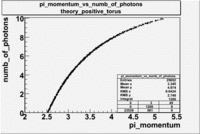
|
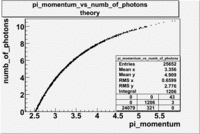
|
| Experiment | B>0 | without cuts | e_flag>10 | 5<e_nphe<15 | 5<e_nphe<15 and e_flag>10 |
|---|---|---|---|---|---|
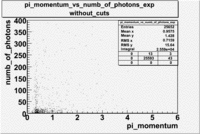
|
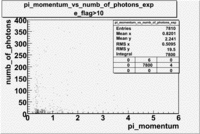
|
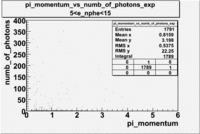
|
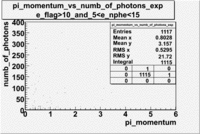
|
ELECTRONS
- e_momentum_vs_number_of_photoelectrons_theory
Add number of detected photons
- Number of Photoelectrons
| Experiment | B>0 | without cuts | flag>10 |
|---|---|---|---|
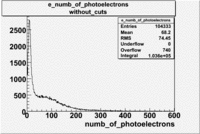
|
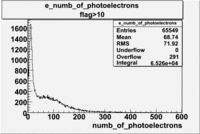
|
- e_Momentum_vs_Number_of_Photoelectrons
Now put a cut on the number of cherenkov photons from electrons ( 5 < Npe < 15) and plot the number of pion cherenkov photons.
| Experiment | B>0 | without cuts | flag>10 | 5<nphe<15 | 5<nphe<15 and flag>10 |
|---|---|---|---|---|---|
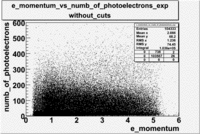
|
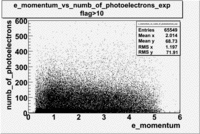
|
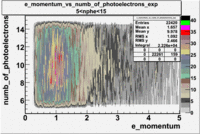
|
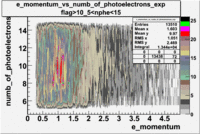
|
p<3 GeV and
p<3 GeV, and
p<3 GeV, , and nphe>2.5
Plot of EC_total vs EC_inner
In this case file dst28181_03.B00 was used(Energy 4.2 GeV and Torus +2250). The following cuts were applied:, , ec_chi_sqr<0.1 and nphe>3.
http://www.jlab.org/Hall-B/secure/eg1/EG2000/sharon/ec_cut_4p2gev/Final_ec_cuts/Electron_cuts.html
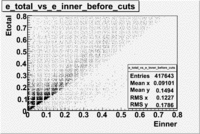
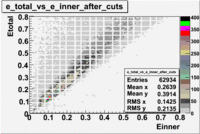
Raster and vertex correction
A raster calibration and a cut on the vertex distribution was made in order to select electrons from the polarized target, also the ones scattered from other materials in the beam path. A plot of the uncorrected vertex distribution is presented below for dst27070_02.B00 file(energy=5.7GeV Torus=2250)
Pion
Summary Table
Tamuna: The pion id code is at:
http://www.jlab.org/Hall-B/secure/eg1/EG2000/josh/pion.cc
| Beam Energy | Torus Current | Begin Run | End Run | file used | # trig() | expected # evts() | p>3,,(%) | p<3,,(%) |
|---|---|---|---|---|---|---|---|---|
| 1606 | 1500 | 25488 | 25559 | dst25504_02.B00 | 60 | 3.2 | ||
| 1606 | 1500 | 25669 | 25732 | dst25669_02.B00 | 226 | 10 | ||
| 1606 | 1500 | 25742 | 26221 | dst25754_02.B00 | 3154 | 13.3 | ||
| 1606 | -1500 | 26222 | 26359 | dst26224_02.B00 | 703 | 13.1 | ||
| 1724 | -1500 | 27644 | 27798 | dst27649_02.B00 | 211 | 20 | ||
| 2288 | 1500 | 27205 | 27351 | dst27225_02.B00 | 1647 | 16.1 | ||
| 2562 | -1500 | 27799 | 27924 | dst27809_02.B00 | 1441 | 13.1 | ||
| 2562 | -1500 | 27942 | 27995 | dst27942_02.B00 | 841 | 32.3 | ||
| 2562 | 1500 | 28001 | 28069 | dst28002_02.B00 | 1013 | 30.7 | ||
| 2792 | -1500 | 27936 | 27941 | dst27937_02.B00 | 69 | 20.6 | ||
| 4239 | 2250 | 28074 | 28277 | dst28075_02.B00 | 2278 | 19.6 | ||
| 4239 | -2250 | 28280 | 28479 | dst28281_02.B00 | 2620 | 15.2 | ||
| 4239 | 2250 | 28506 | 28510 | dst28509_02.B00 | 75 | 18.1 | ||
| 5627 | 2250 | 27356 | 27364 | dst27358_02.B00 | 56 | 19.4 | 36.1 | 31.5 |
| 5627 | -2250 | 27366 | 27380 | dst27368_02.B00 | 130 | 13.6 | 25 | 43.8 |
| 5627 | 2250 | 27386 | 27499 | dst27388_02.B00 | 1210 | 20.2 | 39.8 | 32.4 |
| 5735 | -2250 | 26874 | 27068 | dst26904_02.B00 | 1709 | 19.9 | 22.5 | 46.4 |
| 5735 | 2250 | 27069 | 27198 | dst27070_02.B00 | 1509 | 15 | 34.6 | 32.9 |
| 5764 | -2250 | 26468 | 26722 | dst26489_02.B00 | 1189 | 10 | 25.2 | 44.3 |
| 5764 | -2250 | 26776 | 26851 | dst26779_02.B00 | 662 | 15.9 | 21.3 | 44 |
Table for Pions
I used the pion id code(both subroutines):
http://www.jlab.org/Hall-B/secure/eg1/EG2000/josh/pion.cc
| Beam Energy | Torus Current | Begin Run | End Run | file used | events remaining after cuts | # trig() | expected # evts() | |
|---|---|---|---|---|---|---|---|---|
| first(%) | second(%) | |||||||
| 1606 | 1500 | 25488 | 25559 | dst25504_02.B00 | 96.8 | 99 | 60 | 3.2 |
| 1606 | 1500 | 25669 | 25732 | dst25669_02.B00 | 98.1 | 98.9 | 226 | 10 |
| 1606 | 1500 | 25742 | 26221 | dst25754_02.B00 | 13.4 | 22.8 | 3154 | 13.3 |
| 1606 | -1500 | 26222 | 26359 | dst26224_02.B00 | 11.3 | 15.3 | 703 | 13.1 |
| 1724 | -1500 | 27644 | 27798 | dst27649_02.B00 | 15.3 | 18.7 | 211 | 20 |
| 2288 | 1500 | 27205 | 27351 | dst27225_02.B00 | 16.4 | 18.9 | 1647 | 16.1 |
| 2562 | -1500 | 27799 | 27924 | dst27809_02.B00 | 11.1 | 14.2 | 1441 | 13.1 |
| 2562 | -1500 | 27942 | 27995 | dst27942_02.B00 | 11.1 | 14.2 | 841 | 32.3 |
| 2562 | 1500 | 28001 | 28069 | dst28002_02.B00 | 22.4 | 23.1 | 1013 | 30.7 |
| 2792 | -1500 | 27936 | 27941 | dst27937_02.B00 | 12.3 | 15.4 | 69 | 20.6 |
| 4239 | 2250 | 28074 | 28277 | dst28075_02.B00 | 16.7 | 14.3 | 2278 | 19.6 |
| 4239 | -2250 | 28280 | 28479 | dst28281_02.B00 | 10.4 | 12.6 | 2620 | 15.2 |
| 4239 | 2250 | 28506 | 28510 | dst28509_02.B00 | % | % | 75 | 18.1 |
| 5627 | 2250 | 27356 | 27364 | dst27358_02.B00 | 40.5 | 40.8 | 56 | 19.4 |
| 5627 | -2250 | 27366 | 27380 | dst27368_02.B00 | 9.7 | 12.7 | 130 | 13.6 |
| 5627 | 2250 | 27386 | 27499 | dst27388_02.B00 | 14.1 | 15.5 | 1210 | 20.2 |
| 5735 | -2250 | 26874 | 27068 | dst26904_02.B00 | 12.1 | 14.5 | 1709 | 19.9 |
| 5735 | 2250 | 27069 | 27198 | dst27070_02.B00 | 19.5 | 22.9 | 1509 | 15 |
| 5764 | -2250 | 26468 | 26722 | dst26489_02.B00 | 9.6 | 13.3 | 1189 | 10 |
| 5764 | -2250 | 26776 | 26851 | dst26779_02.B00 | 10.3 | 13.9 | 662 | 15.9 |
Plot of EC_tot/P vs nphe for Pions
Quality Checks
Run Summary Table
The table below uses a characteristic DST file to try and estimate the sample size for a semi-inclusive analysis of pion electroproduction. The column marked "cuts" below indicates the number of events kept when the standard EC based electron identification cuts, described above, are used: and
. The next step will be to compare unpolarized pion production rates in order to evaluate the CLAS detectors efficiencies for measuring charged pions with different torus polarities. The question is whether you get the same rates for negatively charged pions in one torus polarity to positively charged pions using the opposite torus polarity.
Tamar: We need a convention for choosing only one of the pions in events with multiple pions. I believe I chose the pion with the highest momentum before.
| Beam Energy | Torus Current | Target | Begin Run | End Run | file used | # trig() | events remaining after cuts(%) | expected # evts() | events remaining after and cuts(%) | expected # evts() | events remaining after and cuts(%) | expected # evts() |
|---|---|---|---|---|---|---|---|---|---|---|---|---|
| 4239 | 2250 | NH3 | 28205 | 28277 | /cache/mss/home/nguler/dst/dst28205_05.B00 | 1108.72 | 60.8 | 674.1 | 8.3 | 92.02 | 3.24 | 35.92 |
| ND3 | 28074 | 28190 | /cache/mss/home/nguler/dst/dst28187_05.B00 | 1117.87 | 59.6 | 666.25 | 7.99 | 89.32 | 3.3 | 36.9 | ||
| -2250 | NH3 | 28407 | 28479 | /cache/mss/home/nguler/dst/dst28409_05.B00 | 1013.57 | 24.2 | 245.28 | 0.12 | 1.22 | 0 | 0 | |
| ND3 | 28278 | 28403 | /cache/mss/home/nguler/dst/dst28400_05.B00 | 1556.04 | 23.9 | 371.89 | 0.02 | 0.31 | 0.05 | 0.51 | ||
| 5735 | 2250 | NH3 | 27074 | 27195 | /cache/mss/home/nguler/dst/dst27095_05.B00 | 1442.25 | 57.7 | 832.18 | 9.3 | 134.13 | 3.8 | 59.13 |
| ND3 | 27116 | 27170 | /cache/mss/home/nguler/dst/dst27141_05.B00 | 624.55 | 59.1 | 369.10 | 9.53 | 59.52 | 3.9 | 24.36 | ||
| -2250 | NH3 | 26911 | 27015 | /cache/mss/home/nguler/dst/dst26988.B00 | 900.93 | 80.7 | 727.05 | 7.14 | 64.33 | 9.9 | 89.19 | |
| ND3 | 27022 | 27068 | /cache/mss/home/nguler/dst/dst27055_05.B00 | 711.53 | 80 | 569.22 | 6.97 | 49.59 | 10.1 | 71.86 |
Rates
Unpolarized Pion electroproduction
Rates from other experiments in our Kinematic range
Center of Mass Frame Transformation
We have proton and electron. In the Lab frame electron is moving along the x-axis with momentum ; and proton is at rest. The 4-vectors are:
- Lab Frame
- (,,0,0) and for proton :(,0,0,0)
- CM Frame
- :(,,,) and for proton :(,,,)
- Find such that
Using the last two equations we will get the following for x component:
- Example
- : electron mass is neglibible
- : Mass of a proton
;Insert an example event with missing mass close to the proton mass ~ 1 GeV ( 0.8 < W < 1.2).
- : electron mass is neglibible
- : Mass of a proton
- Electron
- Proton
File:Missing mass calculation.ods
Found Event 3939492 with 3 Particles
Start Time=60.46
Raster= 3762 2417
TRIGBITS=16392
Electron Momentum(x,y,z):-0.0183:-0.2849:0.414
DrForest p_id[1]=2
Momentum(x,y,z):0.3127:0.6473:0.7845
DrForest p_id[2]=5
Momentum(x,y,z):-0.4141:-0.3148:0.5887
- Electron
- Proton
Missing Mass
- Table
| file 27141(energy=5.7GeV, B>0, ND3) | event number | missing mass(W) |
|---|---|---|
| 3114490 | 1.24007 | |
| 3114802 | 0.983069 | |
| 3116718 | 0.868544 | |
| 3116940 | 1.14841 | |
| 3118561 | 0.949136 | |
| 3118771 | 0.877746 | |
| 3120003 | 1.00759 | |
| 3120133 | 1.18326 | |
| 3120266 | 1.24695 | |
| 3121495 | 0.977593 | |
| 3122514 | 0.902853 | |
| 3122695 | 1.25198 | |
| 3122705 | 1.22147 | |
| 3122989 | 1.05754 | |
| 3123206 | 0.81068 | |
| 3124104 | 0.948446 | |
| 3124352 | 1.12121 | |
| 3124590 | 1.21016 | |
| 3124638 | 1.14262 | |
| 3124941 | 0.990202 | |
| 3125075 | 1.08905 | |
| 3125102 | 1.19703 |
- Conservation of the 4-momentum gives us following
- Solving it for the final proton state
- In our case 4-vectors for particles are
- Plug and chug
] [ + - -
From from CLAS
where and - are the 4-momentum of the incident and final electron, - the 4-momentum of the target(proton), - the 4-vector of the .
Write equation for in terms of Lab frame Momentum and energy.
Graph for Pions hitting paddle #7. The y-axis should be pion counting rate in units of pions per nanCoulomb.
Pion Rates -vs- Paddle for opposite sign Torus fields
- using all events in which the first particle (the one which caused the trigger) is defined as an electrons and passes the
sc_paddle vs X_bjorken 5.7 GeV Beam Energy
| no cuts | cuts | no cuts | cuts |
|---|---|---|---|
| Electrons | B > 0 | B<0 | |
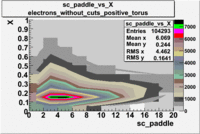
|
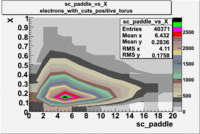
|
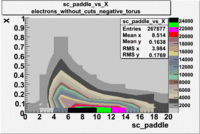
|
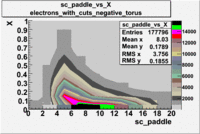
|
| B > 0 | B<0 | ||
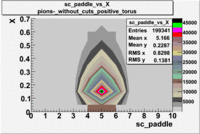
|
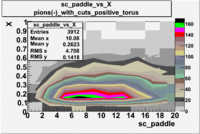
|
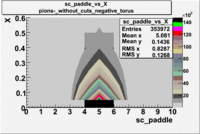
|
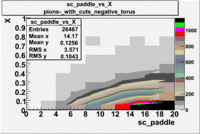
|
| B > 0 | B<0 | ||
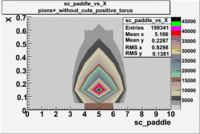
|
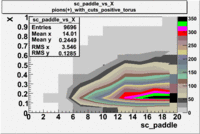
|
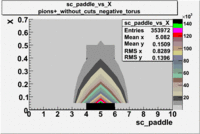
|
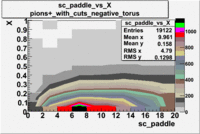
|
sc_paddle vs X_bjorken with cuts 5.7 GeV Beam Energy(number of events=2)
| B>0 | B<0 |
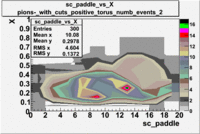
|
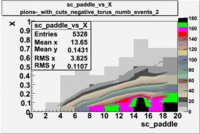
|
| B>0 | B<0 |
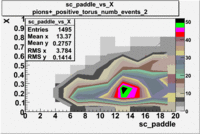
|
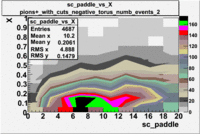
|
sc_paddle vs Momentum 5.7 GeV Beam Energy
There is a curvature problem. When B > 0 then I expect the high momentum electrons to hit the lower paddle numbers (inbending). I can see this when I look at the B>0 plot for electrons with cuts. When B < 0 then the electrons are bending outwards which makes me expect the the higher momentum electrons will high the higher numbered paddles. I do not see this for B>0 with electron cuts.
| no cuts | cuts | no cuts | cuts |
|---|---|---|---|
| Electons | B > 0 | B<0 | |
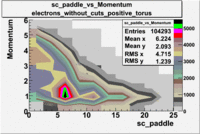
|
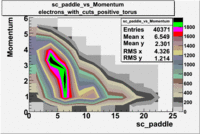
|
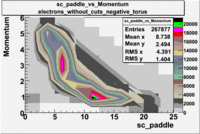
|
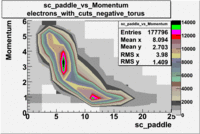
|
| B > 0 | B<0 | ||
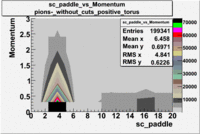
|
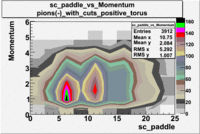 |
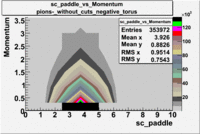
|
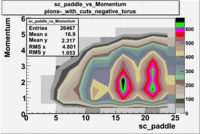 |
| B > 0 | B<0 | ||
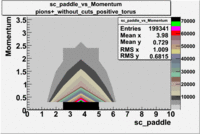
|
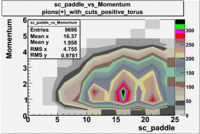 |
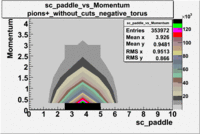
|
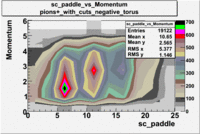 |
sc_paddle vs Momentum with cuts 5.7 GeV Beam Energy(number of events=2)
| B>0 | B<0 |
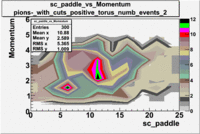
|
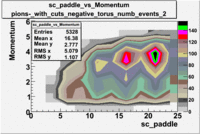
|
| B>0 | B<0 |
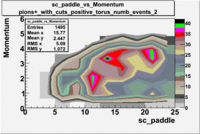
|
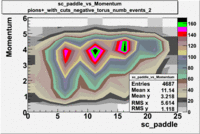
|
Used file dst26988_05.B00(Energy=5.7GeV and Torus=-2250)
Electrons X -vs - paddle number when pion hits paddle 6
Now ask which paddle the electrons hit as a function of X bjorken when we require
that the pion hits paddle #6.
Paddle 7 Rates and statistics
The number of events per trigger is measured for the respective DST file above and then the Total number events in the data set is estimated from that.
| (B>0) | (B<0) | |||
|---|---|---|---|---|
| Total Number Events | Number events per triggers | Total Number Events | Number events per trigger | |
| 0.1 | 5.1 | 71 | 24.6 | 547 |
| 0.2 | 6.9 | 96 | 13.7 | 305 |
| 0.3 | 3.7 | 51 | 6.2 | 137 |
| 0.4 | 3.3 | 45 | 2.7 | 60 |
| 0.5 | 0.9 | 13 | 0.99 | 22 |
Paddle 17 Rates and statistics
| (B<0) | (B>0) | |||
|---|---|---|---|---|
| Total Number Events | Number events per trigger | Total Number Events | Number events per trigger | |
| 0.1 | 6.2 | 137 | 4.6 | 64 |
| 0.2 | 3.5 | 79 | 4.9 | 67 |
| 0.3 | 1.7 | 39 | 2.6 | 36 |
| 0.4 | 0.3 | 7 | 2.1 | 29 |
| 0.5 | 0.1 | 2 | 0.6 | 8 |
Paddle 5 and 8 Rates and statistics for electrons
| sc_paddle=5 (B>0) | sc_paddle=8 (B<0) | |||
|---|---|---|---|---|
| Total Number Events | Number events per trigger | Total Number Events | Number events per trigger | |
| 0.1 | 384.9 | 5.314 | 1665.2 | 3.706 |
| 0.2 | 382.5 | 5.282 | 977.8 | 2.176 |
| 0.3 | 264.9 | 3.657 | 567.1 | 1.262 |
| 0.4 | 159.5 | 2.202 | 328.6 | 0.7313 |
| 0.5 | 99 | 1.367 | 218.2 | 0.4856 |
Histograms for 5.7 GeV Beam Energy
| Electron energy/momentum | Electron Theta () | Electron Qsqrd | Electron X_bjorken |
|---|---|---|---|
| B>0 and sc_paddle=5 | |||
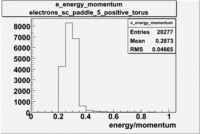
|
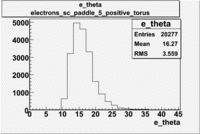
|
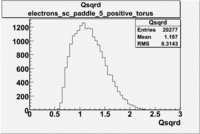
|
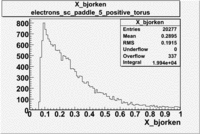
|
| B<0 and sc_paddle=8 | |||
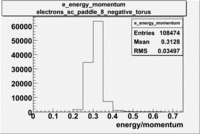
|
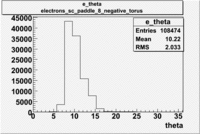
|
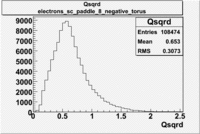
|
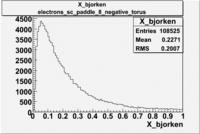
|
Normalized X_bjorken for electrons
| B>0 and sc_paddle=5 | B<0 and sc_paddle=8 |
|---|---|
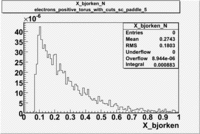
|
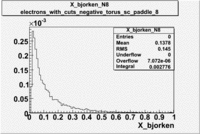
|
- Pion Momentum
- Pion Scattering Angle
- Pion scint paddle number
Make plots using your new analysis code of
Asymmetries
Systematic Errors
Media:SebastianSysErrIncl.pdf Sebastian's Writeup
